Nursing Assignment: Analysis of Non-Cardiac Surgery Patient Journey
VerifiedAdded on 2023/01/18
|11
|2957
|53
Essay
AI Summary
This essay presents a case study of a patient who underwent non-cardiac surgery following coronary stent implantation. The paper meticulously outlines the patient's health history and the rationale behind the surgery. It provides a detailed analysis of the patient's surgical journey, encompassing the pre-operative phase (admission, preparation), the intraoperative phase (surgery itself), and the postoperative phase, including care measures and necessary precautions. The essay emphasizes patient safety routines, the roles of the surgical team, and potential issues that may arise. The essay also discusses the importance of preoperative care in reducing anxiety, the pre-admission assessment process, and the significance of nutrition and hydration. Furthermore, it explores the patient's specific medical history, including the insertion of a DES and subsequent complications. The essay also addresses post-operative care, including vital signs monitoring, pain management, and potential complications, and highlights the importance of teamwork and communication in ensuring patient safety and positive outcomes. The paper adheres to UTAS Harvard Style referencing and the school of Nursing Presentation of Assignments guidelines.
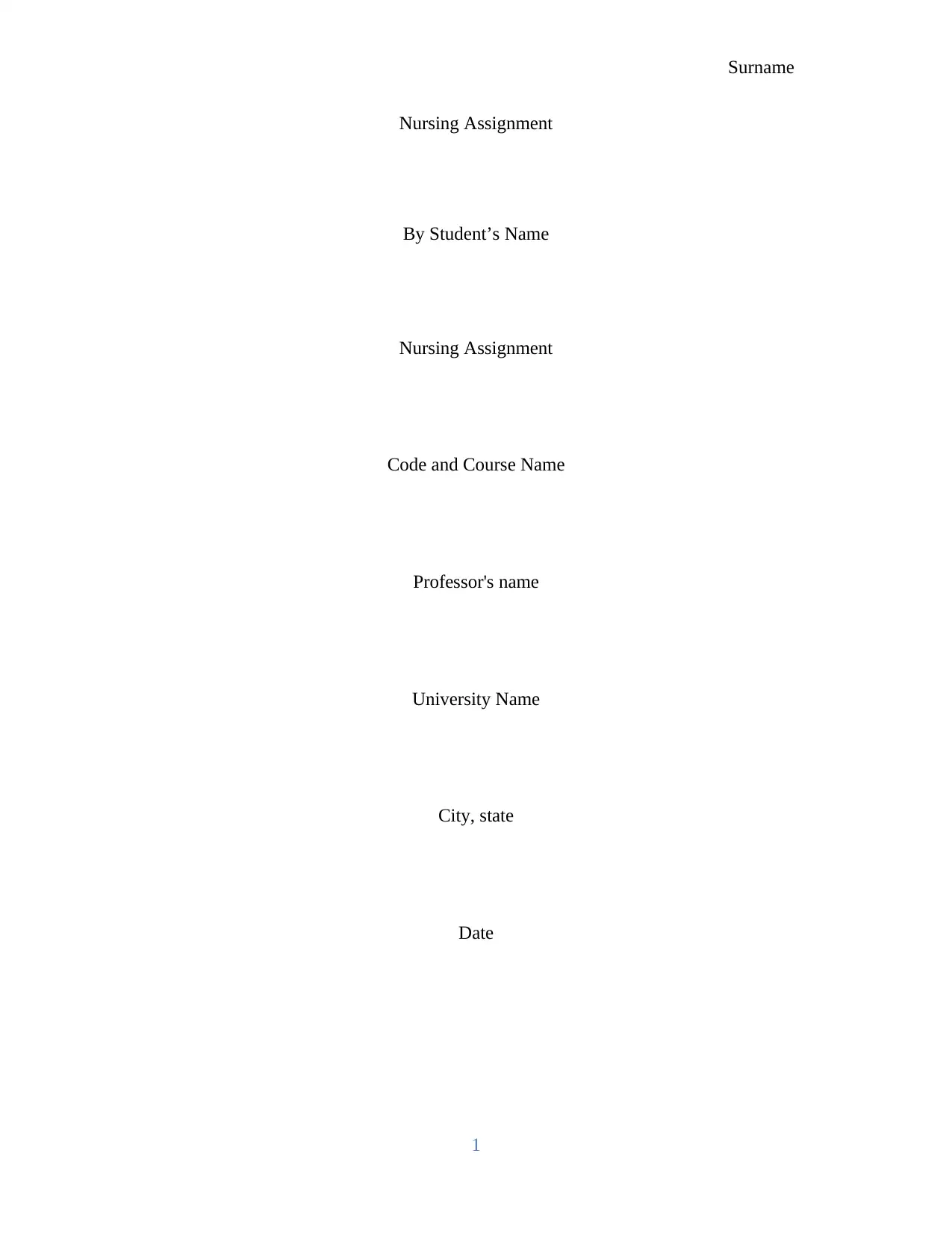
Surname
Nursing Assignment
By Student’s Name
Nursing Assignment
Code and Course Name
Professor's name
University Name
City, state
Date
1
Nursing Assignment
By Student’s Name
Nursing Assignment
Code and Course Name
Professor's name
University Name
City, state
Date
1
Paraphrase This Document
Need a fresh take? Get an instant paraphrase of this document with our AI Paraphraser
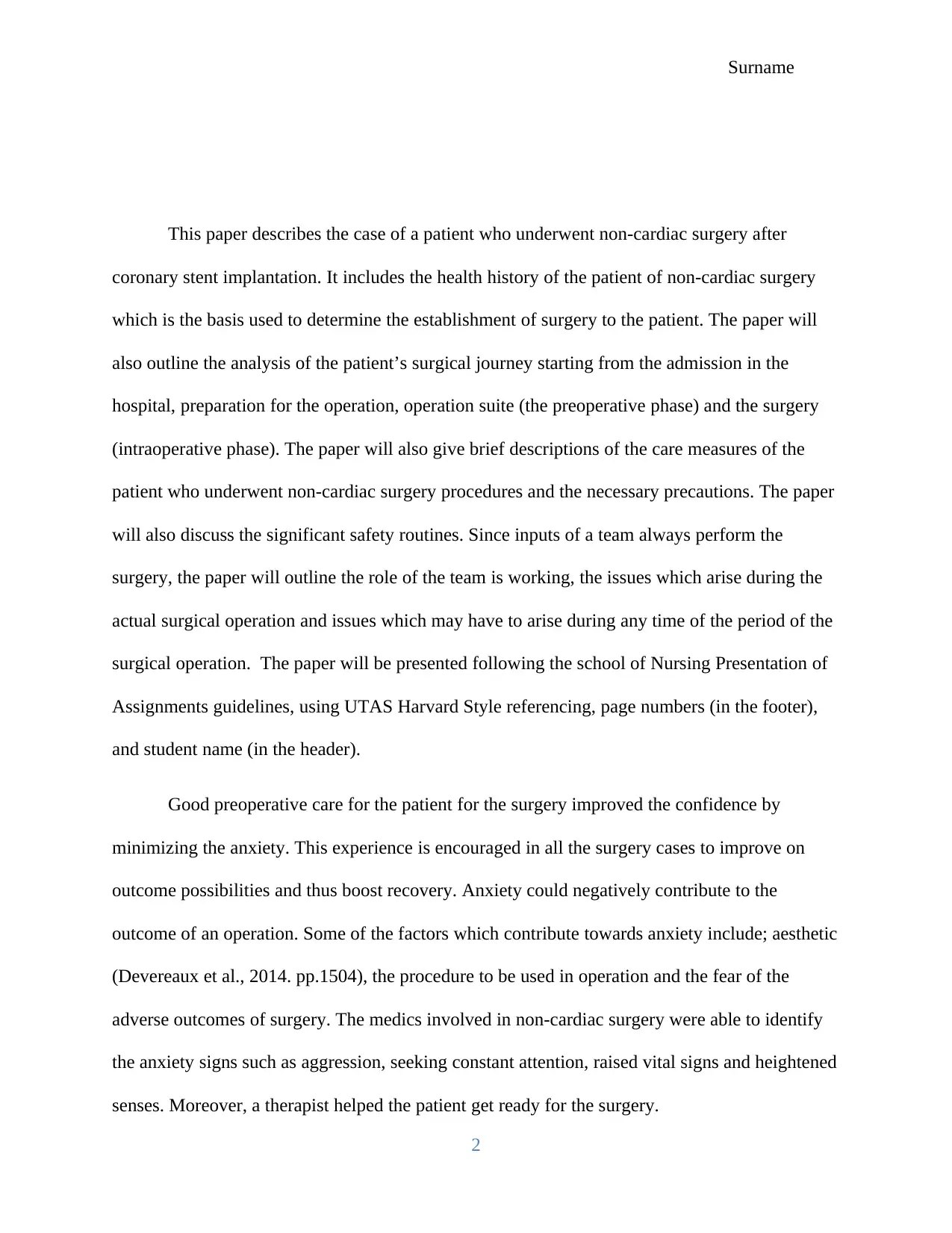
Surname
This paper describes the case of a patient who underwent non-cardiac surgery after
coronary stent implantation. It includes the health history of the patient of non-cardiac surgery
which is the basis used to determine the establishment of surgery to the patient. The paper will
also outline the analysis of the patient’s surgical journey starting from the admission in the
hospital, preparation for the operation, operation suite (the preoperative phase) and the surgery
(intraoperative phase). The paper will also give brief descriptions of the care measures of the
patient who underwent non-cardiac surgery procedures and the necessary precautions. The paper
will also discuss the significant safety routines. Since inputs of a team always perform the
surgery, the paper will outline the role of the team is working, the issues which arise during the
actual surgical operation and issues which may have to arise during any time of the period of the
surgical operation. The paper will be presented following the school of Nursing Presentation of
Assignments guidelines, using UTAS Harvard Style referencing, page numbers (in the footer),
and student name (in the header).
Good preoperative care for the patient for the surgery improved the confidence by
minimizing the anxiety. This experience is encouraged in all the surgery cases to improve on
outcome possibilities and thus boost recovery. Anxiety could negatively contribute to the
outcome of an operation. Some of the factors which contribute towards anxiety include; aesthetic
(Devereaux et al., 2014. pp.1504), the procedure to be used in operation and the fear of the
adverse outcomes of surgery. The medics involved in non-cardiac surgery were able to identify
the anxiety signs such as aggression, seeking constant attention, raised vital signs and heightened
senses. Moreover, a therapist helped the patient get ready for the surgery.
2
This paper describes the case of a patient who underwent non-cardiac surgery after
coronary stent implantation. It includes the health history of the patient of non-cardiac surgery
which is the basis used to determine the establishment of surgery to the patient. The paper will
also outline the analysis of the patient’s surgical journey starting from the admission in the
hospital, preparation for the operation, operation suite (the preoperative phase) and the surgery
(intraoperative phase). The paper will also give brief descriptions of the care measures of the
patient who underwent non-cardiac surgery procedures and the necessary precautions. The paper
will also discuss the significant safety routines. Since inputs of a team always perform the
surgery, the paper will outline the role of the team is working, the issues which arise during the
actual surgical operation and issues which may have to arise during any time of the period of the
surgical operation. The paper will be presented following the school of Nursing Presentation of
Assignments guidelines, using UTAS Harvard Style referencing, page numbers (in the footer),
and student name (in the header).
Good preoperative care for the patient for the surgery improved the confidence by
minimizing the anxiety. This experience is encouraged in all the surgery cases to improve on
outcome possibilities and thus boost recovery. Anxiety could negatively contribute to the
outcome of an operation. Some of the factors which contribute towards anxiety include; aesthetic
(Devereaux et al., 2014. pp.1504), the procedure to be used in operation and the fear of the
adverse outcomes of surgery. The medics involved in non-cardiac surgery were able to identify
the anxiety signs such as aggression, seeking constant attention, raised vital signs and heightened
senses. Moreover, a therapist helped the patient get ready for the surgery.
2
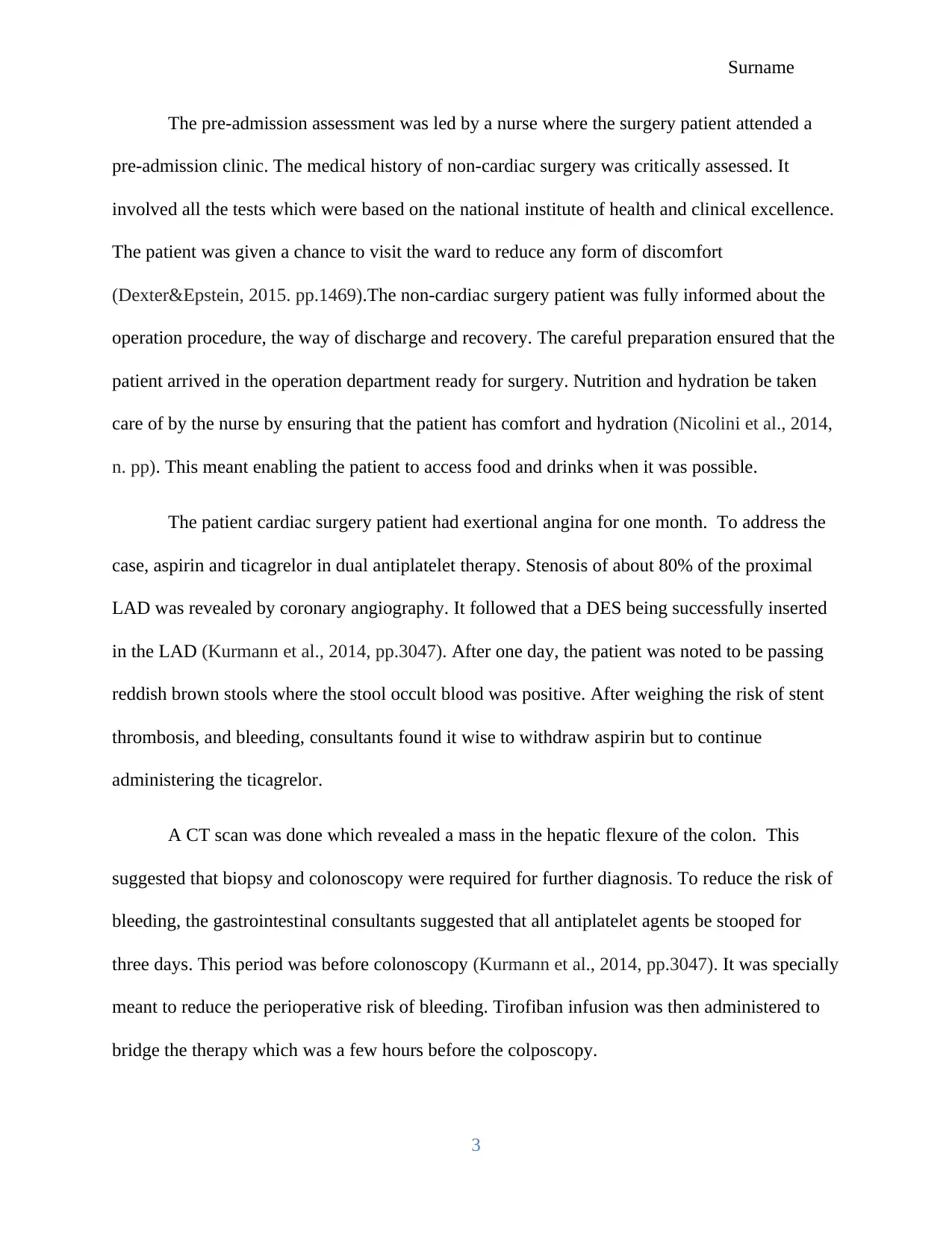
Surname
The pre-admission assessment was led by a nurse where the surgery patient attended a
pre-admission clinic. The medical history of non-cardiac surgery was critically assessed. It
involved all the tests which were based on the national institute of health and clinical excellence.
The patient was given a chance to visit the ward to reduce any form of discomfort
(Dexter&Epstein, 2015. pp.1469).The non-cardiac surgery patient was fully informed about the
operation procedure, the way of discharge and recovery. The careful preparation ensured that the
patient arrived in the operation department ready for surgery. Nutrition and hydration be taken
care of by the nurse by ensuring that the patient has comfort and hydration (Nicolini et al., 2014,
n. pp). This meant enabling the patient to access food and drinks when it was possible.
The patient cardiac surgery patient had exertional angina for one month. To address the
case, aspirin and ticagrelor in dual antiplatelet therapy. Stenosis of about 80% of the proximal
LAD was revealed by coronary angiography. It followed that a DES being successfully inserted
in the LAD (Kurmann et al., 2014, pp.3047). After one day, the patient was noted to be passing
reddish brown stools where the stool occult blood was positive. After weighing the risk of stent
thrombosis, and bleeding, consultants found it wise to withdraw aspirin but to continue
administering the ticagrelor.
A CT scan was done which revealed a mass in the hepatic flexure of the colon. This
suggested that biopsy and colonoscopy were required for further diagnosis. To reduce the risk of
bleeding, the gastrointestinal consultants suggested that all antiplatelet agents be stooped for
three days. This period was before colonoscopy (Kurmann et al., 2014, pp.3047). It was specially
meant to reduce the perioperative risk of bleeding. Tirofiban infusion was then administered to
bridge the therapy which was a few hours before the colposcopy.
3
The pre-admission assessment was led by a nurse where the surgery patient attended a
pre-admission clinic. The medical history of non-cardiac surgery was critically assessed. It
involved all the tests which were based on the national institute of health and clinical excellence.
The patient was given a chance to visit the ward to reduce any form of discomfort
(Dexter&Epstein, 2015. pp.1469).The non-cardiac surgery patient was fully informed about the
operation procedure, the way of discharge and recovery. The careful preparation ensured that the
patient arrived in the operation department ready for surgery. Nutrition and hydration be taken
care of by the nurse by ensuring that the patient has comfort and hydration (Nicolini et al., 2014,
n. pp). This meant enabling the patient to access food and drinks when it was possible.
The patient cardiac surgery patient had exertional angina for one month. To address the
case, aspirin and ticagrelor in dual antiplatelet therapy. Stenosis of about 80% of the proximal
LAD was revealed by coronary angiography. It followed that a DES being successfully inserted
in the LAD (Kurmann et al., 2014, pp.3047). After one day, the patient was noted to be passing
reddish brown stools where the stool occult blood was positive. After weighing the risk of stent
thrombosis, and bleeding, consultants found it wise to withdraw aspirin but to continue
administering the ticagrelor.
A CT scan was done which revealed a mass in the hepatic flexure of the colon. This
suggested that biopsy and colonoscopy were required for further diagnosis. To reduce the risk of
bleeding, the gastrointestinal consultants suggested that all antiplatelet agents be stooped for
three days. This period was before colonoscopy (Kurmann et al., 2014, pp.3047). It was specially
meant to reduce the perioperative risk of bleeding. Tirofiban infusion was then administered to
bridge the therapy which was a few hours before the colposcopy.
3
⊘ This is a preview!⊘
Do you want full access?
Subscribe today to unlock all pages.

Trusted by 1+ million students worldwide
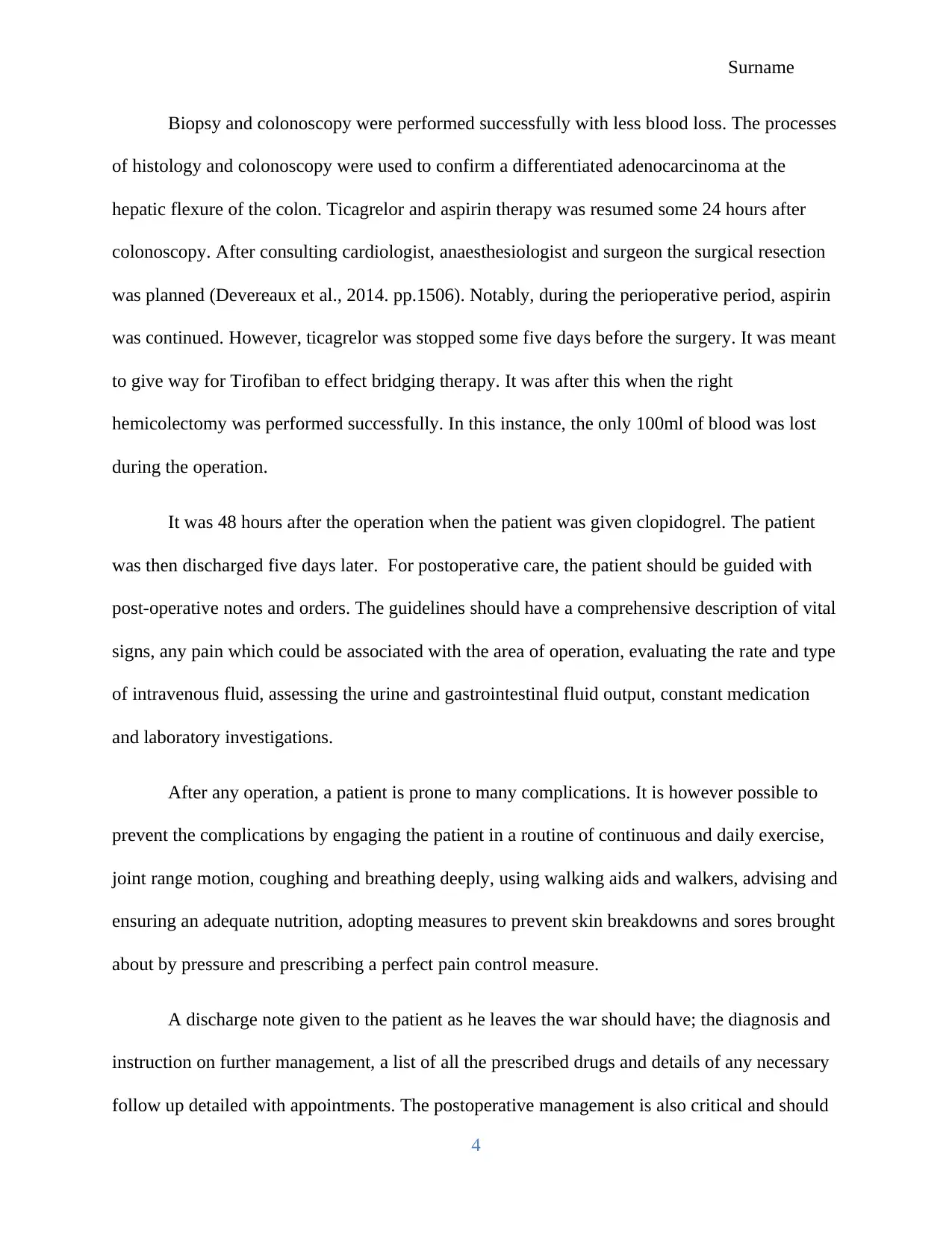
Surname
Biopsy and colonoscopy were performed successfully with less blood loss. The processes
of histology and colonoscopy were used to confirm a differentiated adenocarcinoma at the
hepatic flexure of the colon. Ticagrelor and aspirin therapy was resumed some 24 hours after
colonoscopy. After consulting cardiologist, anaesthesiologist and surgeon the surgical resection
was planned (Devereaux et al., 2014. pp.1506). Notably, during the perioperative period, aspirin
was continued. However, ticagrelor was stopped some five days before the surgery. It was meant
to give way for Tirofiban to effect bridging therapy. It was after this when the right
hemicolectomy was performed successfully. In this instance, the only 100ml of blood was lost
during the operation.
It was 48 hours after the operation when the patient was given clopidogrel. The patient
was then discharged five days later. For postoperative care, the patient should be guided with
post-operative notes and orders. The guidelines should have a comprehensive description of vital
signs, any pain which could be associated with the area of operation, evaluating the rate and type
of intravenous fluid, assessing the urine and gastrointestinal fluid output, constant medication
and laboratory investigations.
After any operation, a patient is prone to many complications. It is however possible to
prevent the complications by engaging the patient in a routine of continuous and daily exercise,
joint range motion, coughing and breathing deeply, using walking aids and walkers, advising and
ensuring an adequate nutrition, adopting measures to prevent skin breakdowns and sores brought
about by pressure and prescribing a perfect pain control measure.
A discharge note given to the patient as he leaves the war should have; the diagnosis and
instruction on further management, a list of all the prescribed drugs and details of any necessary
follow up detailed with appointments. The postoperative management is also critical and should
4
Biopsy and colonoscopy were performed successfully with less blood loss. The processes
of histology and colonoscopy were used to confirm a differentiated adenocarcinoma at the
hepatic flexure of the colon. Ticagrelor and aspirin therapy was resumed some 24 hours after
colonoscopy. After consulting cardiologist, anaesthesiologist and surgeon the surgical resection
was planned (Devereaux et al., 2014. pp.1506). Notably, during the perioperative period, aspirin
was continued. However, ticagrelor was stopped some five days before the surgery. It was meant
to give way for Tirofiban to effect bridging therapy. It was after this when the right
hemicolectomy was performed successfully. In this instance, the only 100ml of blood was lost
during the operation.
It was 48 hours after the operation when the patient was given clopidogrel. The patient
was then discharged five days later. For postoperative care, the patient should be guided with
post-operative notes and orders. The guidelines should have a comprehensive description of vital
signs, any pain which could be associated with the area of operation, evaluating the rate and type
of intravenous fluid, assessing the urine and gastrointestinal fluid output, constant medication
and laboratory investigations.
After any operation, a patient is prone to many complications. It is however possible to
prevent the complications by engaging the patient in a routine of continuous and daily exercise,
joint range motion, coughing and breathing deeply, using walking aids and walkers, advising and
ensuring an adequate nutrition, adopting measures to prevent skin breakdowns and sores brought
about by pressure and prescribing a perfect pain control measure.
A discharge note given to the patient as he leaves the war should have; the diagnosis and
instruction on further management, a list of all the prescribed drugs and details of any necessary
follow up detailed with appointments. The postoperative management is also critical and should
4
Paraphrase This Document
Need a fresh take? Get an instant paraphrase of this document with our AI Paraphraser
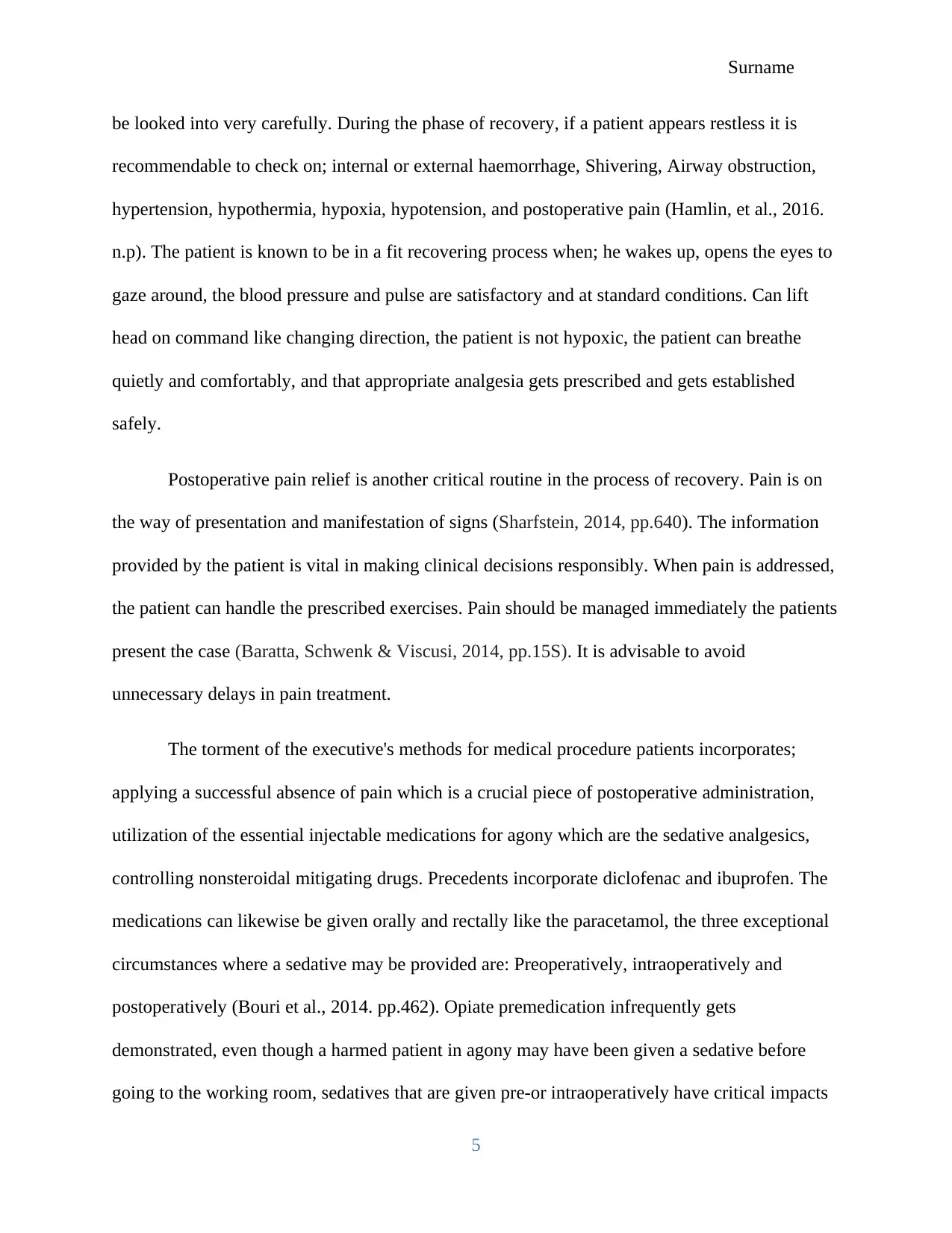
Surname
be looked into very carefully. During the phase of recovery, if a patient appears restless it is
recommendable to check on; internal or external haemorrhage, Shivering, Airway obstruction,
hypertension, hypothermia, hypoxia, hypotension, and postoperative pain (Hamlin, et al., 2016.
n.p). The patient is known to be in a fit recovering process when; he wakes up, opens the eyes to
gaze around, the blood pressure and pulse are satisfactory and at standard conditions. Can lift
head on command like changing direction, the patient is not hypoxic, the patient can breathe
quietly and comfortably, and that appropriate analgesia gets prescribed and gets established
safely.
Postoperative pain relief is another critical routine in the process of recovery. Pain is on
the way of presentation and manifestation of signs (Sharfstein, 2014, pp.640). The information
provided by the patient is vital in making clinical decisions responsibly. When pain is addressed,
the patient can handle the prescribed exercises. Pain should be managed immediately the patients
present the case (Baratta, Schwenk & Viscusi, 2014, pp.15S). It is advisable to avoid
unnecessary delays in pain treatment.
The torment of the executive's methods for medical procedure patients incorporates;
applying a successful absence of pain which is a crucial piece of postoperative administration,
utilization of the essential injectable medications for agony which are the sedative analgesics,
controlling nonsteroidal mitigating drugs. Precedents incorporate diclofenac and ibuprofen. The
medications can likewise be given orally and rectally like the paracetamol, the three exceptional
circumstances where a sedative may be provided are: Preoperatively, intraoperatively and
postoperatively (Bouri et al., 2014. pp.462). Opiate premedication infrequently gets
demonstrated, even though a harmed patient in agony may have been given a sedative before
going to the working room, sedatives that are given pre-or intraoperatively have critical impacts
5
be looked into very carefully. During the phase of recovery, if a patient appears restless it is
recommendable to check on; internal or external haemorrhage, Shivering, Airway obstruction,
hypertension, hypothermia, hypoxia, hypotension, and postoperative pain (Hamlin, et al., 2016.
n.p). The patient is known to be in a fit recovering process when; he wakes up, opens the eyes to
gaze around, the blood pressure and pulse are satisfactory and at standard conditions. Can lift
head on command like changing direction, the patient is not hypoxic, the patient can breathe
quietly and comfortably, and that appropriate analgesia gets prescribed and gets established
safely.
Postoperative pain relief is another critical routine in the process of recovery. Pain is on
the way of presentation and manifestation of signs (Sharfstein, 2014, pp.640). The information
provided by the patient is vital in making clinical decisions responsibly. When pain is addressed,
the patient can handle the prescribed exercises. Pain should be managed immediately the patients
present the case (Baratta, Schwenk & Viscusi, 2014, pp.15S). It is advisable to avoid
unnecessary delays in pain treatment.
The torment of the executive's methods for medical procedure patients incorporates;
applying a successful absence of pain which is a crucial piece of postoperative administration,
utilization of the essential injectable medications for agony which are the sedative analgesics,
controlling nonsteroidal mitigating drugs. Precedents incorporate diclofenac and ibuprofen. The
medications can likewise be given orally and rectally like the paracetamol, the three exceptional
circumstances where a sedative may be provided are: Preoperatively, intraoperatively and
postoperatively (Bouri et al., 2014. pp.462). Opiate premedication infrequently gets
demonstrated, even though a harmed patient in agony may have been given a sedative before
going to the working room, sedatives that are given pre-or intraoperatively have critical impacts
5
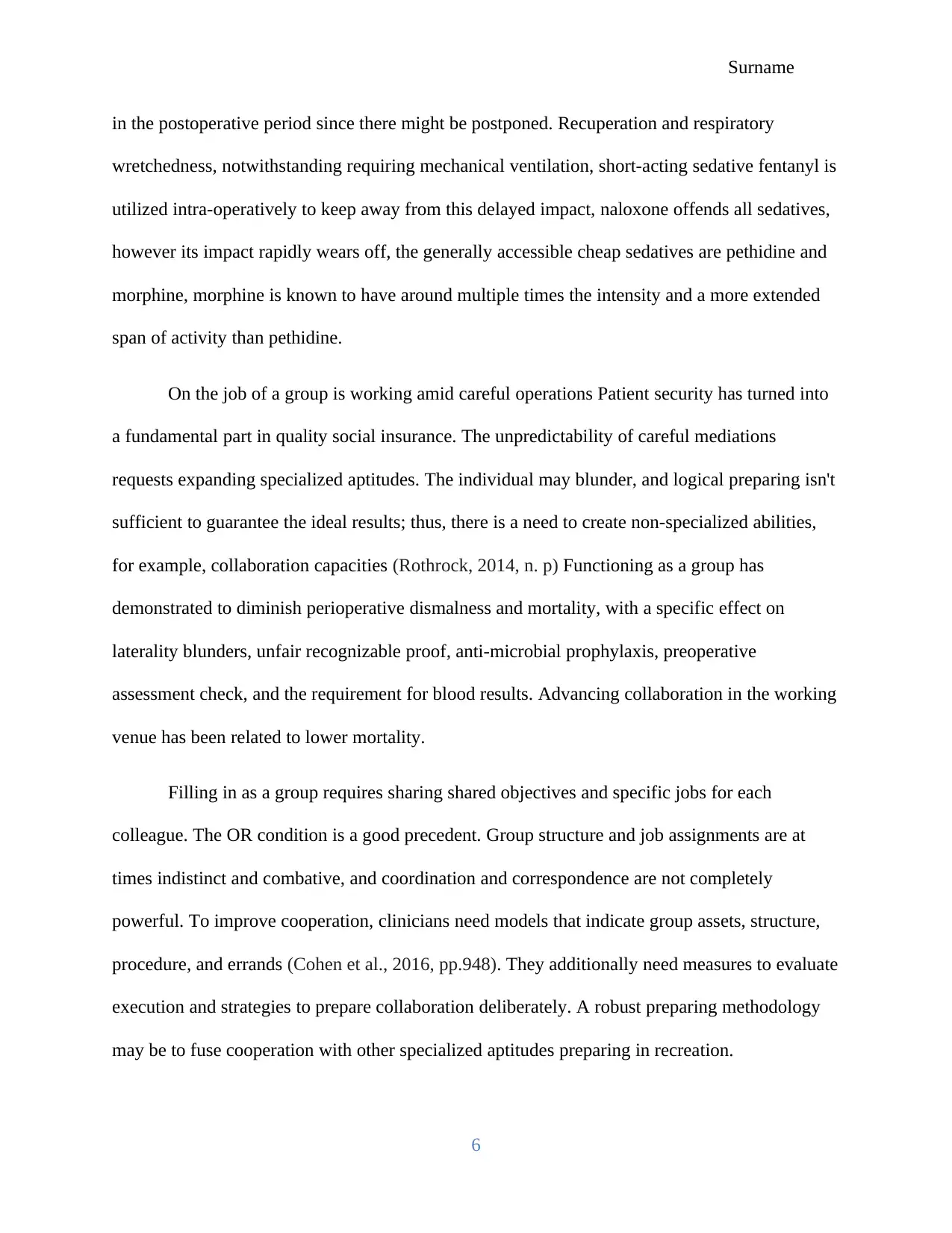
Surname
in the postoperative period since there might be postponed. Recuperation and respiratory
wretchedness, notwithstanding requiring mechanical ventilation, short-acting sedative fentanyl is
utilized intra-operatively to keep away from this delayed impact, naloxone offends all sedatives,
however its impact rapidly wears off, the generally accessible cheap sedatives are pethidine and
morphine, morphine is known to have around multiple times the intensity and a more extended
span of activity than pethidine.
On the job of a group is working amid careful operations Patient security has turned into
a fundamental part in quality social insurance. The unpredictability of careful mediations
requests expanding specialized aptitudes. The individual may blunder, and logical preparing isn't
sufficient to guarantee the ideal results; thus, there is a need to create non-specialized abilities,
for example, collaboration capacities (Rothrock, 2014, n. p) Functioning as a group has
demonstrated to diminish perioperative dismalness and mortality, with a specific effect on
laterality blunders, unfair recognizable proof, anti-microbial prophylaxis, preoperative
assessment check, and the requirement for blood results. Advancing collaboration in the working
venue has been related to lower mortality.
Filling in as a group requires sharing shared objectives and specific jobs for each
colleague. The OR condition is a good precedent. Group structure and job assignments are at
times indistinct and combative, and coordination and correspondence are not completely
powerful. To improve cooperation, clinicians need models that indicate group assets, structure,
procedure, and errands (Cohen et al., 2016, pp.948). They additionally need measures to evaluate
execution and strategies to prepare collaboration deliberately. A robust preparing methodology
may be to fuse cooperation with other specialized aptitudes preparing in recreation.
6
in the postoperative period since there might be postponed. Recuperation and respiratory
wretchedness, notwithstanding requiring mechanical ventilation, short-acting sedative fentanyl is
utilized intra-operatively to keep away from this delayed impact, naloxone offends all sedatives,
however its impact rapidly wears off, the generally accessible cheap sedatives are pethidine and
morphine, morphine is known to have around multiple times the intensity and a more extended
span of activity than pethidine.
On the job of a group is working amid careful operations Patient security has turned into
a fundamental part in quality social insurance. The unpredictability of careful mediations
requests expanding specialized aptitudes. The individual may blunder, and logical preparing isn't
sufficient to guarantee the ideal results; thus, there is a need to create non-specialized abilities,
for example, collaboration capacities (Rothrock, 2014, n. p) Functioning as a group has
demonstrated to diminish perioperative dismalness and mortality, with a specific effect on
laterality blunders, unfair recognizable proof, anti-microbial prophylaxis, preoperative
assessment check, and the requirement for blood results. Advancing collaboration in the working
venue has been related to lower mortality.
Filling in as a group requires sharing shared objectives and specific jobs for each
colleague. The OR condition is a good precedent. Group structure and job assignments are at
times indistinct and combative, and coordination and correspondence are not completely
powerful. To improve cooperation, clinicians need models that indicate group assets, structure,
procedure, and errands (Cohen et al., 2016, pp.948). They additionally need measures to evaluate
execution and strategies to prepare collaboration deliberately. A robust preparing methodology
may be to fuse cooperation with other specialized aptitudes preparing in recreation.
6
⊘ This is a preview!⊘
Do you want full access?
Subscribe today to unlock all pages.

Trusted by 1+ million students worldwide
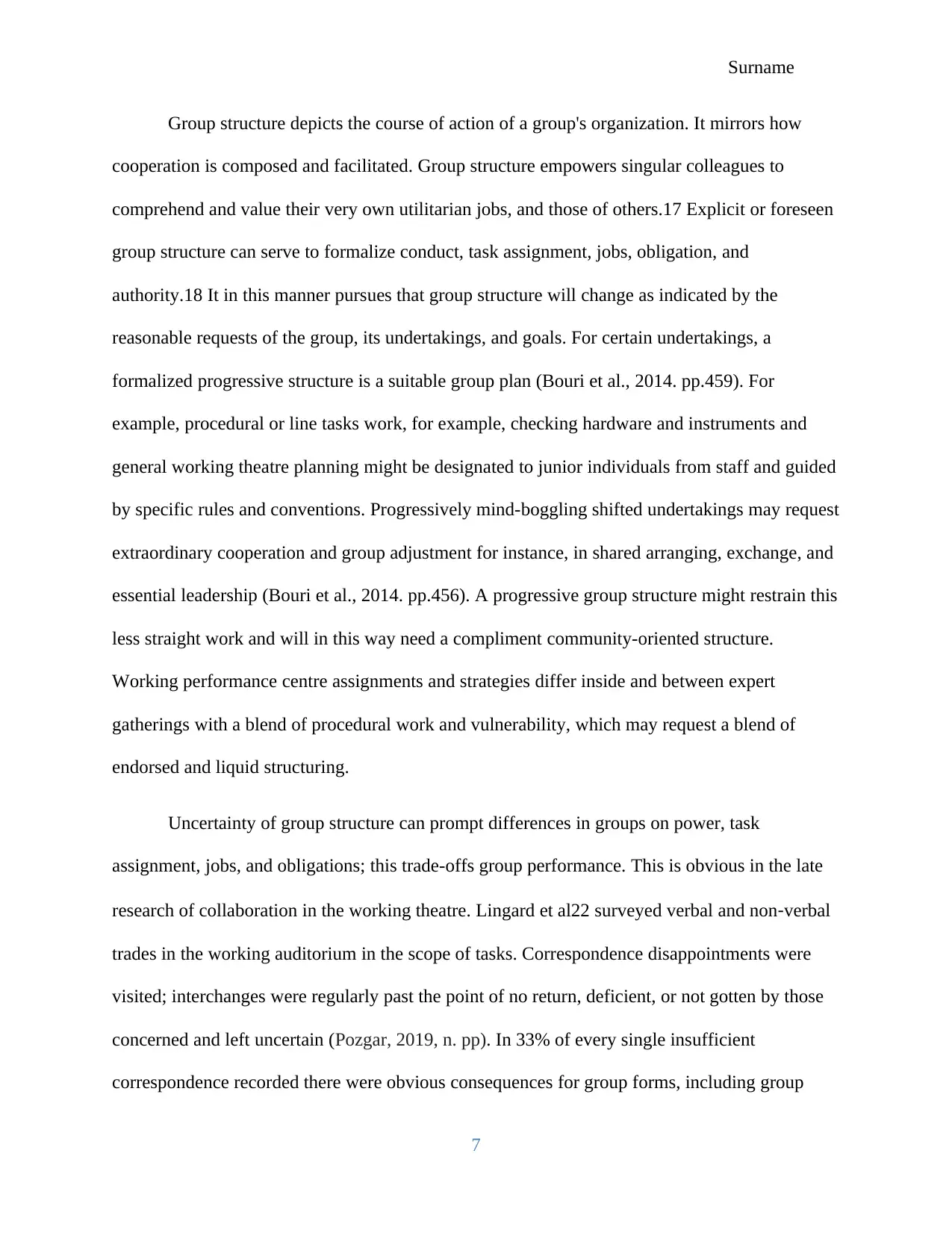
Surname
Group structure depicts the course of action of a group's organization. It mirrors how
cooperation is composed and facilitated. Group structure empowers singular colleagues to
comprehend and value their very own utilitarian jobs, and those of others.17 Explicit or foreseen
group structure can serve to formalize conduct, task assignment, jobs, obligation, and
authority.18 It in this manner pursues that group structure will change as indicated by the
reasonable requests of the group, its undertakings, and goals. For certain undertakings, a
formalized progressive structure is a suitable group plan (Bouri et al., 2014. pp.459). For
example, procedural or line tasks work, for example, checking hardware and instruments and
general working theatre planning might be designated to junior individuals from staff and guided
by specific rules and conventions. Progressively mind-boggling shifted undertakings may request
extraordinary cooperation and group adjustment for instance, in shared arranging, exchange, and
essential leadership (Bouri et al., 2014. pp.456). A progressive group structure might restrain this
less straight work and will in this way need a compliment community-oriented structure.
Working performance centre assignments and strategies differ inside and between expert
gatherings with a blend of procedural work and vulnerability, which may request a blend of
endorsed and liquid structuring.
Uncertainty of group structure can prompt differences in groups on power, task
assignment, jobs, and obligations; this trade-offs group performance. This is obvious in the late
research of collaboration in the working theatre. Lingard et al22 surveyed verbal and non‐verbal
trades in the working auditorium in the scope of tasks. Correspondence disappointments were
visited; interchanges were regularly past the point of no return, deficient, or not gotten by those
concerned and left uncertain (Pozgar, 2019, n. pp). In 33% of every single insufficient
correspondence recorded there were obvious consequences for group forms, including group
7
Group structure depicts the course of action of a group's organization. It mirrors how
cooperation is composed and facilitated. Group structure empowers singular colleagues to
comprehend and value their very own utilitarian jobs, and those of others.17 Explicit or foreseen
group structure can serve to formalize conduct, task assignment, jobs, obligation, and
authority.18 It in this manner pursues that group structure will change as indicated by the
reasonable requests of the group, its undertakings, and goals. For certain undertakings, a
formalized progressive structure is a suitable group plan (Bouri et al., 2014. pp.459). For
example, procedural or line tasks work, for example, checking hardware and instruments and
general working theatre planning might be designated to junior individuals from staff and guided
by specific rules and conventions. Progressively mind-boggling shifted undertakings may request
extraordinary cooperation and group adjustment for instance, in shared arranging, exchange, and
essential leadership (Bouri et al., 2014. pp.456). A progressive group structure might restrain this
less straight work and will in this way need a compliment community-oriented structure.
Working performance centre assignments and strategies differ inside and between expert
gatherings with a blend of procedural work and vulnerability, which may request a blend of
endorsed and liquid structuring.
Uncertainty of group structure can prompt differences in groups on power, task
assignment, jobs, and obligations; this trade-offs group performance. This is obvious in the late
research of collaboration in the working theatre. Lingard et al22 surveyed verbal and non‐verbal
trades in the working auditorium in the scope of tasks. Correspondence disappointments were
visited; interchanges were regularly past the point of no return, deficient, or not gotten by those
concerned and left uncertain (Pozgar, 2019, n. pp). In 33% of every single insufficient
correspondence recorded there were obvious consequences for group forms, including group
7
Paraphrase This Document
Need a fresh take? Get an instant paraphrase of this document with our AI Paraphraser
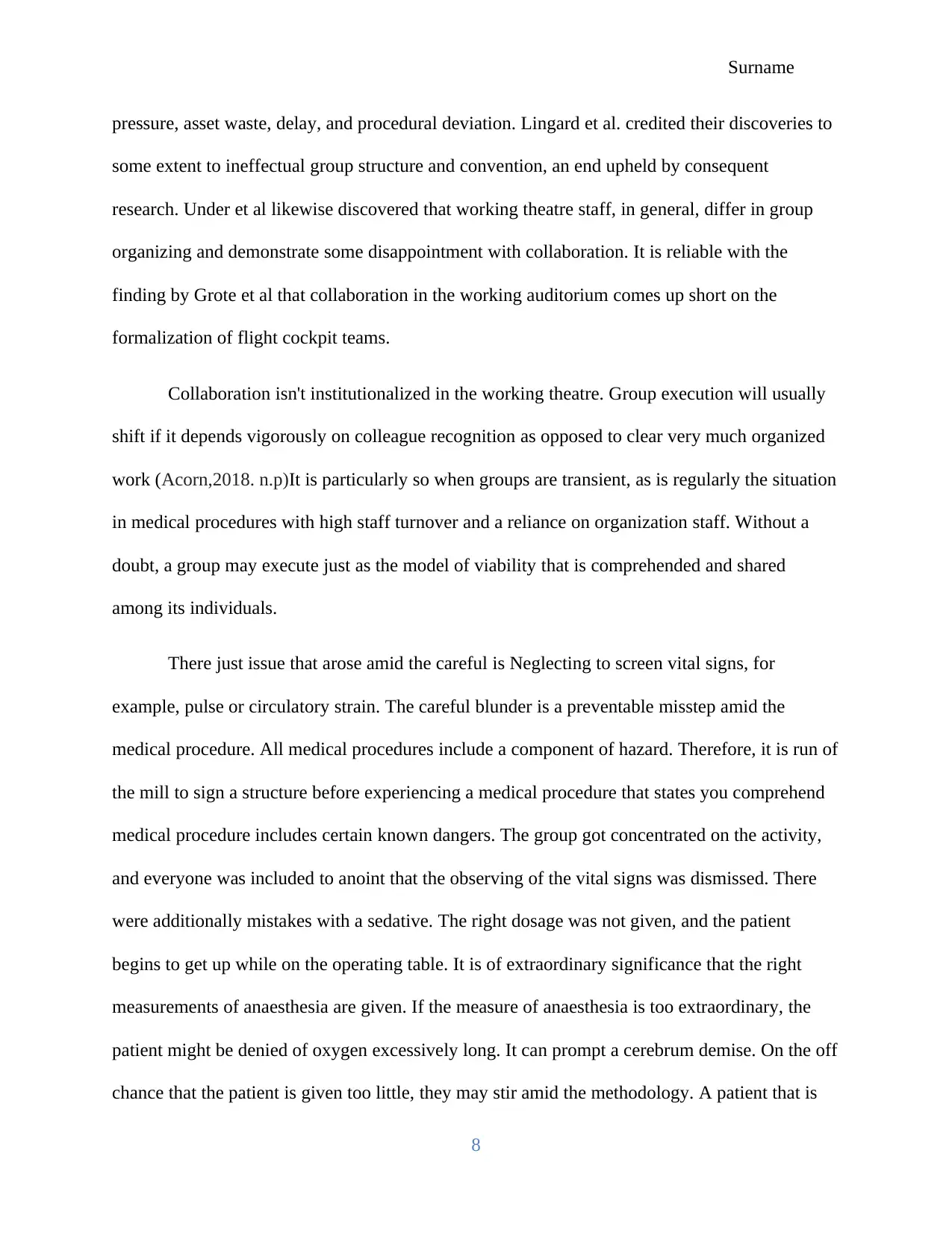
Surname
pressure, asset waste, delay, and procedural deviation. Lingard et al. credited their discoveries to
some extent to ineffectual group structure and convention, an end upheld by consequent
research. Under et al likewise discovered that working theatre staff, in general, differ in group
organizing and demonstrate some disappointment with collaboration. It is reliable with the
finding by Grote et al that collaboration in the working auditorium comes up short on the
formalization of flight cockpit teams.
Collaboration isn't institutionalized in the working theatre. Group execution will usually
shift if it depends vigorously on colleague recognition as opposed to clear very much organized
work (Acorn,2018. n.p)It is particularly so when groups are transient, as is regularly the situation
in medical procedures with high staff turnover and a reliance on organization staff. Without a
doubt, a group may execute just as the model of viability that is comprehended and shared
among its individuals.
There just issue that arose amid the careful is Neglecting to screen vital signs, for
example, pulse or circulatory strain. The careful blunder is a preventable misstep amid the
medical procedure. All medical procedures include a component of hazard. Therefore, it is run of
the mill to sign a structure before experiencing a medical procedure that states you comprehend
medical procedure includes certain known dangers. The group got concentrated on the activity,
and everyone was included to anoint that the observing of the vital signs was dismissed. There
were additionally mistakes with a sedative. The right dosage was not given, and the patient
begins to get up while on the operating table. It is of extraordinary significance that the right
measurements of anaesthesia are given. If the measure of anaesthesia is too extraordinary, the
patient might be denied of oxygen excessively long. It can prompt a cerebrum demise. On the off
chance that the patient is given too little, they may stir amid the methodology. A patient that is
8
pressure, asset waste, delay, and procedural deviation. Lingard et al. credited their discoveries to
some extent to ineffectual group structure and convention, an end upheld by consequent
research. Under et al likewise discovered that working theatre staff, in general, differ in group
organizing and demonstrate some disappointment with collaboration. It is reliable with the
finding by Grote et al that collaboration in the working auditorium comes up short on the
formalization of flight cockpit teams.
Collaboration isn't institutionalized in the working theatre. Group execution will usually
shift if it depends vigorously on colleague recognition as opposed to clear very much organized
work (Acorn,2018. n.p)It is particularly so when groups are transient, as is regularly the situation
in medical procedures with high staff turnover and a reliance on organization staff. Without a
doubt, a group may execute just as the model of viability that is comprehended and shared
among its individuals.
There just issue that arose amid the careful is Neglecting to screen vital signs, for
example, pulse or circulatory strain. The careful blunder is a preventable misstep amid the
medical procedure. All medical procedures include a component of hazard. Therefore, it is run of
the mill to sign a structure before experiencing a medical procedure that states you comprehend
medical procedure includes certain known dangers. The group got concentrated on the activity,
and everyone was included to anoint that the observing of the vital signs was dismissed. There
were additionally mistakes with a sedative. The right dosage was not given, and the patient
begins to get up while on the operating table. It is of extraordinary significance that the right
measurements of anaesthesia are given. If the measure of anaesthesia is too extraordinary, the
patient might be denied of oxygen excessively long. It can prompt a cerebrum demise. On the off
chance that the patient is given too little, they may stir amid the methodology. A patient that is
8

Surname
cognizant amid a medical procedure would be in many agonies. Seeing a specialist jab around
your body may likewise be mentally scarring.
9
cognizant amid a medical procedure would be in many agonies. Seeing a specialist jab around
your body may likewise be mentally scarring.
9
⊘ This is a preview!⊘
Do you want full access?
Subscribe today to unlock all pages.

Trusted by 1+ million students worldwide
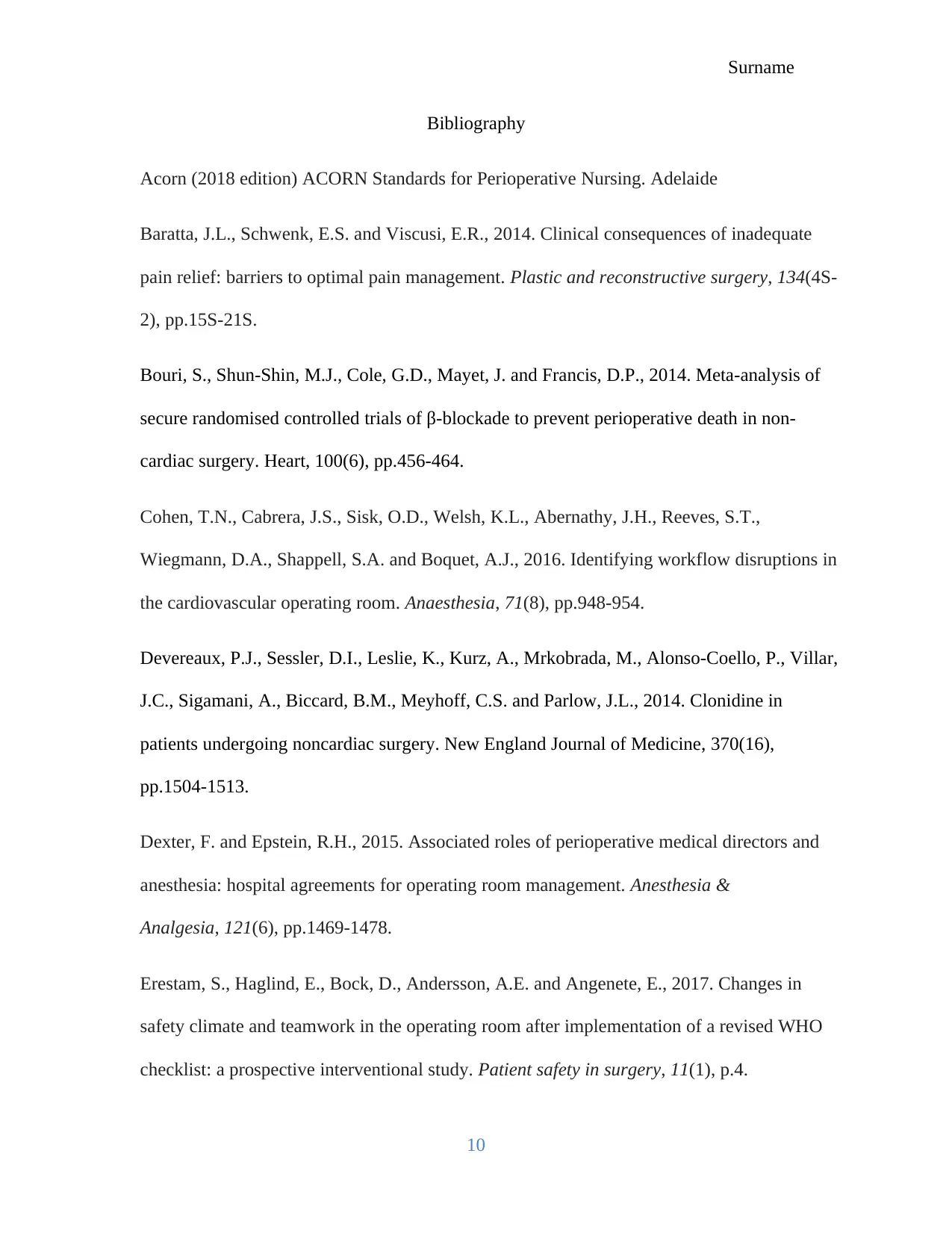
Surname
Bibliography
Acorn (2018 edition) ACORN Standards for Perioperative Nursing. Adelaide
Baratta, J.L., Schwenk, E.S. and Viscusi, E.R., 2014. Clinical consequences of inadequate
pain relief: barriers to optimal pain management. Plastic and reconstructive surgery, 134(4S-
2), pp.15S-21S.
Bouri, S., Shun-Shin, M.J., Cole, G.D., Mayet, J. and Francis, D.P., 2014. Meta-analysis of
secure randomised controlled trials of β-blockade to prevent perioperative death in non-
cardiac surgery. Heart, 100(6), pp.456-464.
Cohen, T.N., Cabrera, J.S., Sisk, O.D., Welsh, K.L., Abernathy, J.H., Reeves, S.T.,
Wiegmann, D.A., Shappell, S.A. and Boquet, A.J., 2016. Identifying workflow disruptions in
the cardiovascular operating room. Anaesthesia, 71(8), pp.948-954.
Devereaux, P.J., Sessler, D.I., Leslie, K., Kurz, A., Mrkobrada, M., Alonso-Coello, P., Villar,
J.C., Sigamani, A., Biccard, B.M., Meyhoff, C.S. and Parlow, J.L., 2014. Clonidine in
patients undergoing noncardiac surgery. New England Journal of Medicine, 370(16),
pp.1504-1513.
Dexter, F. and Epstein, R.H., 2015. Associated roles of perioperative medical directors and
anesthesia: hospital agreements for operating room management. Anesthesia &
Analgesia, 121(6), pp.1469-1478.
Erestam, S., Haglind, E., Bock, D., Andersson, A.E. and Angenete, E., 2017. Changes in
safety climate and teamwork in the operating room after implementation of a revised WHO
checklist: a prospective interventional study. Patient safety in surgery, 11(1), p.4.
10
Bibliography
Acorn (2018 edition) ACORN Standards for Perioperative Nursing. Adelaide
Baratta, J.L., Schwenk, E.S. and Viscusi, E.R., 2014. Clinical consequences of inadequate
pain relief: barriers to optimal pain management. Plastic and reconstructive surgery, 134(4S-
2), pp.15S-21S.
Bouri, S., Shun-Shin, M.J., Cole, G.D., Mayet, J. and Francis, D.P., 2014. Meta-analysis of
secure randomised controlled trials of β-blockade to prevent perioperative death in non-
cardiac surgery. Heart, 100(6), pp.456-464.
Cohen, T.N., Cabrera, J.S., Sisk, O.D., Welsh, K.L., Abernathy, J.H., Reeves, S.T.,
Wiegmann, D.A., Shappell, S.A. and Boquet, A.J., 2016. Identifying workflow disruptions in
the cardiovascular operating room. Anaesthesia, 71(8), pp.948-954.
Devereaux, P.J., Sessler, D.I., Leslie, K., Kurz, A., Mrkobrada, M., Alonso-Coello, P., Villar,
J.C., Sigamani, A., Biccard, B.M., Meyhoff, C.S. and Parlow, J.L., 2014. Clonidine in
patients undergoing noncardiac surgery. New England Journal of Medicine, 370(16),
pp.1504-1513.
Dexter, F. and Epstein, R.H., 2015. Associated roles of perioperative medical directors and
anesthesia: hospital agreements for operating room management. Anesthesia &
Analgesia, 121(6), pp.1469-1478.
Erestam, S., Haglind, E., Bock, D., Andersson, A.E. and Angenete, E., 2017. Changes in
safety climate and teamwork in the operating room after implementation of a revised WHO
checklist: a prospective interventional study. Patient safety in surgery, 11(1), p.4.
10
Paraphrase This Document
Need a fresh take? Get an instant paraphrase of this document with our AI Paraphraser
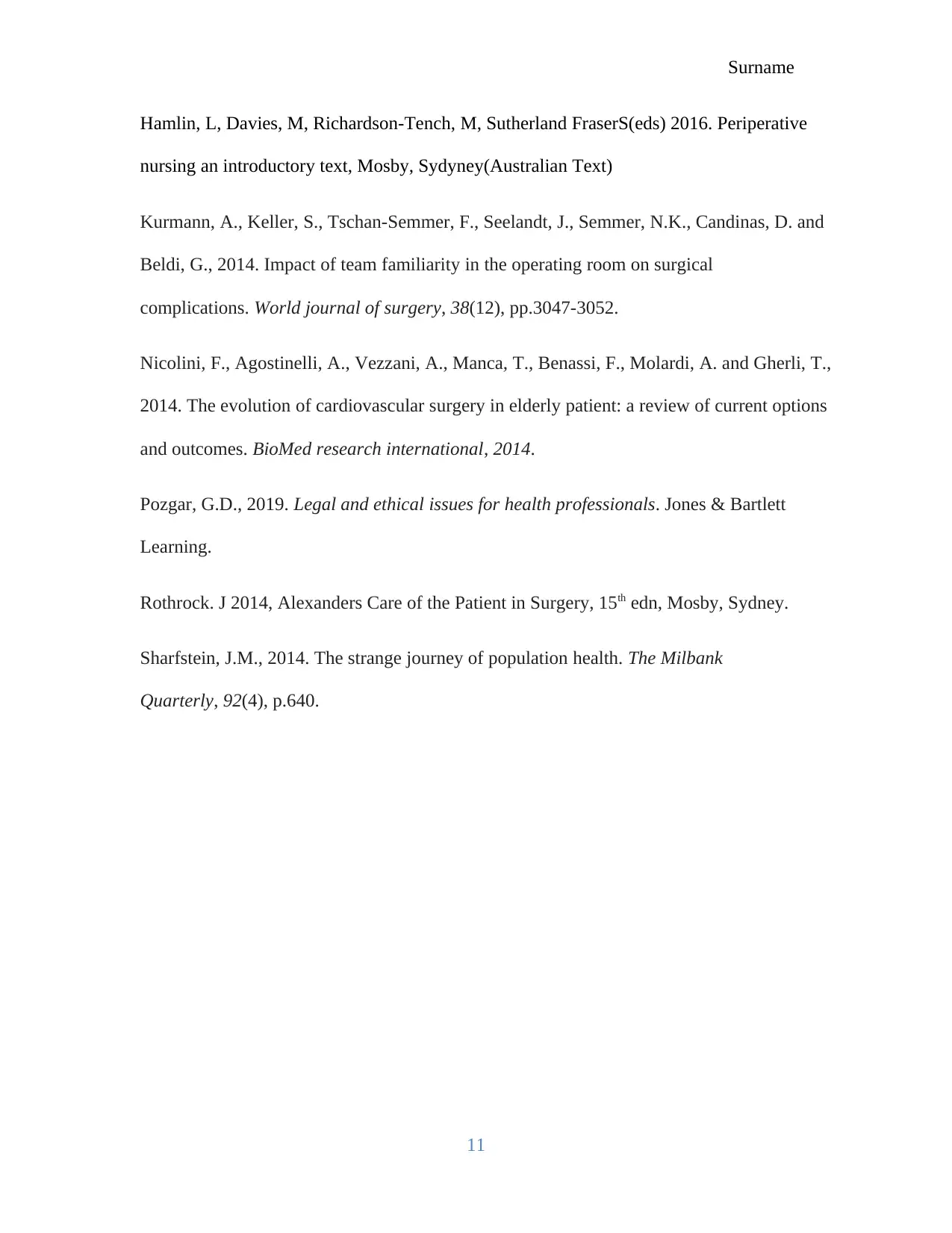
Surname
Hamlin, L, Davies, M, Richardson-Tench, M, Sutherland FraserS(eds) 2016. Periperative
nursing an introductory text, Mosby, Sydyney(Australian Text)
Kurmann, A., Keller, S., Tschan-Semmer, F., Seelandt, J., Semmer, N.K., Candinas, D. and
Beldi, G., 2014. Impact of team familiarity in the operating room on surgical
complications. World journal of surgery, 38(12), pp.3047-3052.
Nicolini, F., Agostinelli, A., Vezzani, A., Manca, T., Benassi, F., Molardi, A. and Gherli, T.,
2014. The evolution of cardiovascular surgery in elderly patient: a review of current options
and outcomes. BioMed research international, 2014.
Pozgar, G.D., 2019. Legal and ethical issues for health professionals. Jones & Bartlett
Learning.
Rothrock. J 2014, Alexanders Care of the Patient in Surgery, 15th edn, Mosby, Sydney.
Sharfstein, J.M., 2014. The strange journey of population health. The Milbank
Quarterly, 92(4), p.640.
11
Hamlin, L, Davies, M, Richardson-Tench, M, Sutherland FraserS(eds) 2016. Periperative
nursing an introductory text, Mosby, Sydyney(Australian Text)
Kurmann, A., Keller, S., Tschan-Semmer, F., Seelandt, J., Semmer, N.K., Candinas, D. and
Beldi, G., 2014. Impact of team familiarity in the operating room on surgical
complications. World journal of surgery, 38(12), pp.3047-3052.
Nicolini, F., Agostinelli, A., Vezzani, A., Manca, T., Benassi, F., Molardi, A. and Gherli, T.,
2014. The evolution of cardiovascular surgery in elderly patient: a review of current options
and outcomes. BioMed research international, 2014.
Pozgar, G.D., 2019. Legal and ethical issues for health professionals. Jones & Bartlett
Learning.
Rothrock. J 2014, Alexanders Care of the Patient in Surgery, 15th edn, Mosby, Sydney.
Sharfstein, J.M., 2014. The strange journey of population health. The Milbank
Quarterly, 92(4), p.640.
11
1 out of 11
Related Documents
Your All-in-One AI-Powered Toolkit for Academic Success.
+13062052269
info@desklib.com
Available 24*7 on WhatsApp / Email
![[object Object]](/_next/static/media/star-bottom.7253800d.svg)
Unlock your academic potential
Copyright © 2020–2025 A2Z Services. All Rights Reserved. Developed and managed by ZUCOL.





